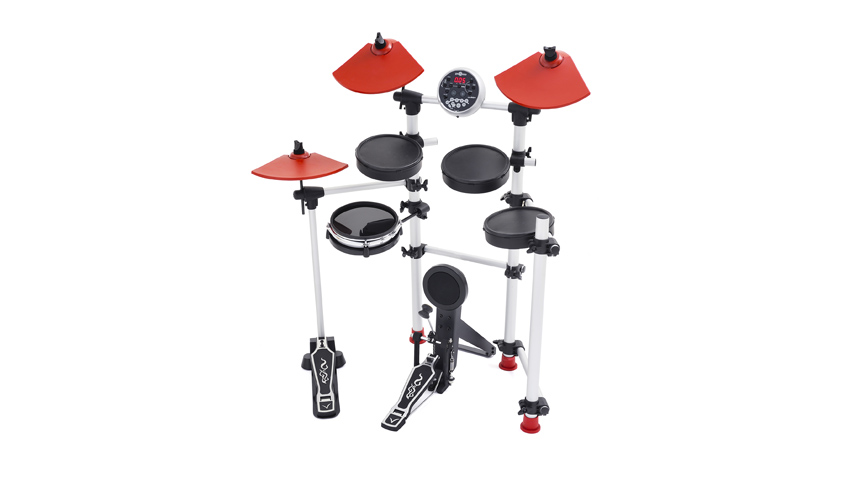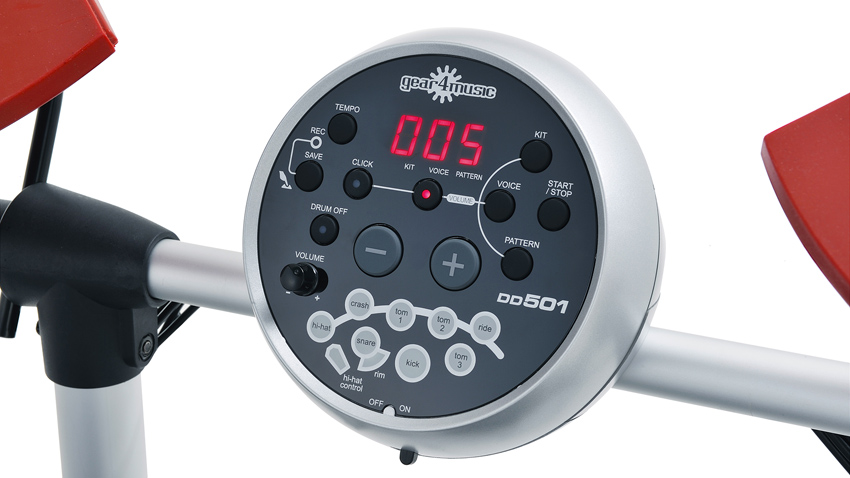MusicRadar Verdict
You soon forget that you are playing a smaller sized rack, quickly acclimatising without having to alter your technique. This is a great little kit which will give any beginner a good foothold into the world of drumming.
Pros
- +
Snare is dual-zoned. Cables are hidden. Easy assembly.
Cons
- -
The sounds are reasonable rather than mind-blowing.
MusicRadar's got your back

Gear4Music DD501

Gear4Music DD501
The DD501 is an entry-level 5-piece electronic drum set which has been around for some three years. This may seem a relatively short space of time, but in the area of electronics and music, many instruments have aged prematurely as new models have superseded them. Fortunately, this set has a USB port, expanding your connectivity options and ensuring longevity.
Build
This is a fairly compact 5-piece electronic kit comprising three triangular shaped pads for the cymbals (designated as ride, crash and hi-hat), three tom pads, kick pad, pedal for hi-hat controller, single chain drive bass drum pedal (with reversible beater), set of sticks, the all-essential wiring loom and, of course, the DD501 drum module itself.
Daringly different, this kit successfully breaks away from the traditional 'any colour you like, as long as its black!' scheme with magenta rack feet and cymbal pads in tasteful contrast to the bare-naked aluminium drum stands.
The individual tom pads have a traditional e-kit rubberised surface and each has a single piezo transducer (making them 'single-zoned' pads). The snare sports a shiny 8" ebony head, triple-flange chrome steel hoop (along with four tension bolts) and, quite surprisingly, this pad is dual-zoned to give extra triggering capabilities - a rarity at this price point. This provides the user with a far more realistic playing experience with the ability to use some of the usual snare playing techniques such as rim shots and cross-sticking.
One of the downsides of many electronic kits is the sheer number of interconnecting cables between each of the pads and the drum module. However, there's a unique rack profile that's shaped a bit like a letter 'C'. This not only adds additional strength to the comparatively small, non-standard diameter tubing, but it also provides a means to discretely hide the cables, making the kit much tidier and safer, too.
To the rear of the spherical melon-sized module there are just six sockets: the multi-trigger input of the DB-25 connector, 9-volt power adaptor, phones, output, mix-in and USB. While the phones and output are self-explanatory, those not familiar with 'mix-in' will be pleased to know that they can connect any audio source (such as an iPod or CD player) and jam along to their favourite tracks with the sound of the kit and the audio 'mixed' and audible through either the headphones or via the stereo output.
Hands On
In a similar way to Roland's TD-11K, other than lifting the drum stand rack out of the box and unfolding it, there is very little to do to complete the set up of the rack itself. The assembly process is also speeded up by the clear cable labelling and the male DB-25 connector into the module. With the pads attached and connections made to the kick pad and hi-hat controller, the kit is ready and raring to go.
Of course, we wouldn't be without our familiar General MIDI sounds and selection of all too cheesy demo tunes (with some rather outrageous pitch bends). While some are really too much to bear for any length of time, in fairness, there are other tracks which are really rather good - an example would be the Santana sound-alike. Still, as each song can be played at a variety of tempos (with or without the drums) this little kit can give a lot of enjoyment and encourage any youngster to play.
Altering the sound of the metronome comes in handy when you're playing in more complex time signatures. You can change the usual click and bell on the down-stroke to a recorded voice. However, this option should be used with care; we set the module to a fast tempo in 3/8 time and it nearly drove us to madness!
There is a reasonable but not exactly mind-blowing selection of sounds here. Importantly, there are a couple of decent snares and kicks and some useful percussion, too. However, you are not simply limited to the sound of the system itself - thanks to the onboard USB port this kit can not only be used to play virtual kits that are powered by computer software, but the DD501 can also work in conjunction with tutorial applications when hooked up to a Mac or PC.
“Chinese Democracy was a boring record. But calling it Guns N' Roses was not honest. It was totally a solo record”: GN’R’s ex manager takes aim at Axl Rose
“Instead of labouring over a perfect recreation, we decided to make an expanded counterpart”: Chase Bliss teams up with Mike Piera for Analog Man collab based on the legendary King Of Tone
“It’s about delivering the most in-demand mods straight from the factory”: Fender hot-rods itself as the Player II Modified Series rolls out the upgrades – and it got IDLES to demo them









